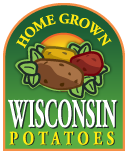In the September 2013 Badger Common’Tater
The Badger Beat
Tips for Potato Storage in 2013
By Dr. A.J. Bussan, UW Dept. of Horticulture
The storage of the 2013 potato crop poses opportunities for a number of potato growers. The current research focus within my research program has been on improving the long-term storability of potatoes and overcoming critical physiological defects to improve crop value. We will preview the upcoming potato storage season based on current crop conditions, provide summary of research on new varieties, stem-end defect in potato, and managing shrink in storage. For the full story, read the September 2013 edition of The Badger Common’Tater.
Hancock Field Day
July 23, 2013
Wisconsin Potato & Vegetable Storage Research Facility and the UW Hancock Agricultural Research Station, Hancock, WI
UW Assistant Professor and Extension Plant Pathologist Dr. Amanda Gevens describes some of her research projects being conducted at the Hancock Ag Research Station (HARS). These trials include evaluation of in-furrow and seed-applied fungicides for control of pink rot, Rhizoctonia and silver scurf. Each trial contains numbered fungicides that are still in the pipeline for registration as well as recently registered products such as Emesto Silver. Gevens also evaluates foliar early blight resistance in approximately 40 cultivars and breeding lines. She further maintains a long-term disease plot to investigate rotation, fumigation and vine kill benefits for control of potato early dying. Finally, Gevens conducts numerous trials in the Storage Research Facility, and has found that the use of Phostrol and Stadium are effective in the control of diseases such as Late blight, pink rot and silver scurf. See more photos from the Hancock Field Day in the September issue of The Badger Common’Tater.
Why are we still growing Russet Burbank?
Part II. Being Better Than Russet Burbank is the Easy Part
By Dr. Paul C. Bethke and Dr. Alvin J. Bussan, UW Dept. of Horticulture
There will come a time when Russet Burbank is rarely grown and becomes the subject of legend. Without a doubt there are many stories to tell. It became the most successful potato variety ever developed in the United States. Russet Burbank was the potato that made Idaho Potatoes famous. It was the spud that Ray Kroc used to create an empire. It became the gold standard for how a baked potato should look and how it should taste. It was the foundation upon which the frozen process industry was built.
There was a darker side to Russet Burbank, and that too is part of the legend. It was an unforgiving variety that brought frustration and occasionally hardship to growers because of its propensity for producing small tubers, misshapen tubers and fries with sugar ends. Those that learned to meet its needs survived, some thrived, but many moved on. Fresh market growers abandoned it for varieties that produced tubers with greater uniformity in size and shape and better pack out.
Russet Burbank still dominates the market for frozen products. For potato breeders, the search for a fry processing variety to replace Russet Burbank became a quest worthy of Don Quixote. For years there was the dream that each new variety would be “the one”, only to have hope fade in the end. There was a riddle to be solved, as happens in many legends. What is better than Russet Burbank, and the same as Russet Burbank? The riddle remains unanswered, and the tale has no end – for now.
To get the full story, get the September 2013 edition of The Badger Common’Tater.





